The main goal of making a starter from Bran is to simplify the process of creating a new starter. Judging the rise, determining the proper hydration and feed ratios, knowing when the starter has fully matured (among other things) are not easily determined for those that are new to the process.
During the Covid Virus outbreak, The Fresh Loaf has experienced a huge influx of new bakers. Many of these new bakers are finding it difficult to succeed. When I think about it, almost all of us struggled our fist time! The Bran Starter is the "brain child" of Michael Wilson, aka "mwilson" on TFL. He asked me to conduct an experiment and instructed me on his concept of the process to build this new type starter. He believed that, since the bran housed most (possibly all) of the microbes necessary for the yeast and LAB of a SD starter, that a culture very similar to a Yeast Water could be built more easily. After following his instructions, I think he is right!
I compiled a YouTube video to document the experiment.
Use THIS LINK for the best viewing experience. The video was shortened for brevity. Pause the video to read the text and study the images.
Continuing Data
Refrigerated the liquid starter on May 7. Removed from refrigerator May 18. It was fizzing exactly like you would expect a Yeast Water to act.
Danny
Well if pandemics don't just breed innovation. You and Michael are definitely onto something. I'm about to move across the country with my starter riding shotgun in multiple forms (wet & dry). Now I know how I'll start a new one if mine doesn't survive the journey.
Thanks for putting together that video Danny!
Tom
Safe travels, Tom. I wish you and your bride well! I hope the new home is the best ever and the neighbors become some of your best friends.
Danny
Thank you Danny. It will be an adventure.
fwiw, my 'bride' is my wife of 26 years -- nothing new about that part. 26 years of adventure in fact ;-)
You be safe too and we'll keep in touch, probably including from the road.
Tom
I've started a batch this morning. Will report on its progress.
Your experiment will provide valuable data. Hopefully the starter can evolve into something that is simple to have success. Also it is my hope that we can find ingredients that are readily available to most bakers.
I have an idea that soaking whole grain berries in water and supplying the needed sugar will work.
I encourage others to experiment with various options.
Danny
24 hours in and it is fermenting. The bran is mostly on the bottom and a huge bubble rose up out of it when I moved the container. There is a thin layer of foam on top. Smells nice. I can't hear it but then I'm deaf above 4 kHz. I'll ask my wife to listen later.
3 days in mine has collapsed. It was super active and then went dormant. Adding more barley malt syrup had no impact. I mixed some with flour but got little response.
Gary, what you describe sounds exactly what I observed with mine. I never added flour, but when additional barley syrup was added it would start to ferment after a few (2 or 3 hr ?) hours. Have you given it some time?
It is possible if some time has elapsed since add syrup that the starter fermented and died back down without your notice.
I gave it 24 hours. I could see a bit of motion with particles rising and falling but very little. The flour mixture has been going for 8 hours and has done very little.
This was with store bought bran which is what I assume most beginners would be most likely to have available.
Gary, if you feed it sugar again, watch it over the following 3 hours from time to time. My starter (all 3) went through sugar quickly.
There are now 3 starters made from 3 individual liquid starters that have been converted to flour. They have risen and fell several times each and are not sitting in the fridge.
OK, I have just given it 16 grams of table sugar. I'll watch it this evening.
No visible activity after 2 hours.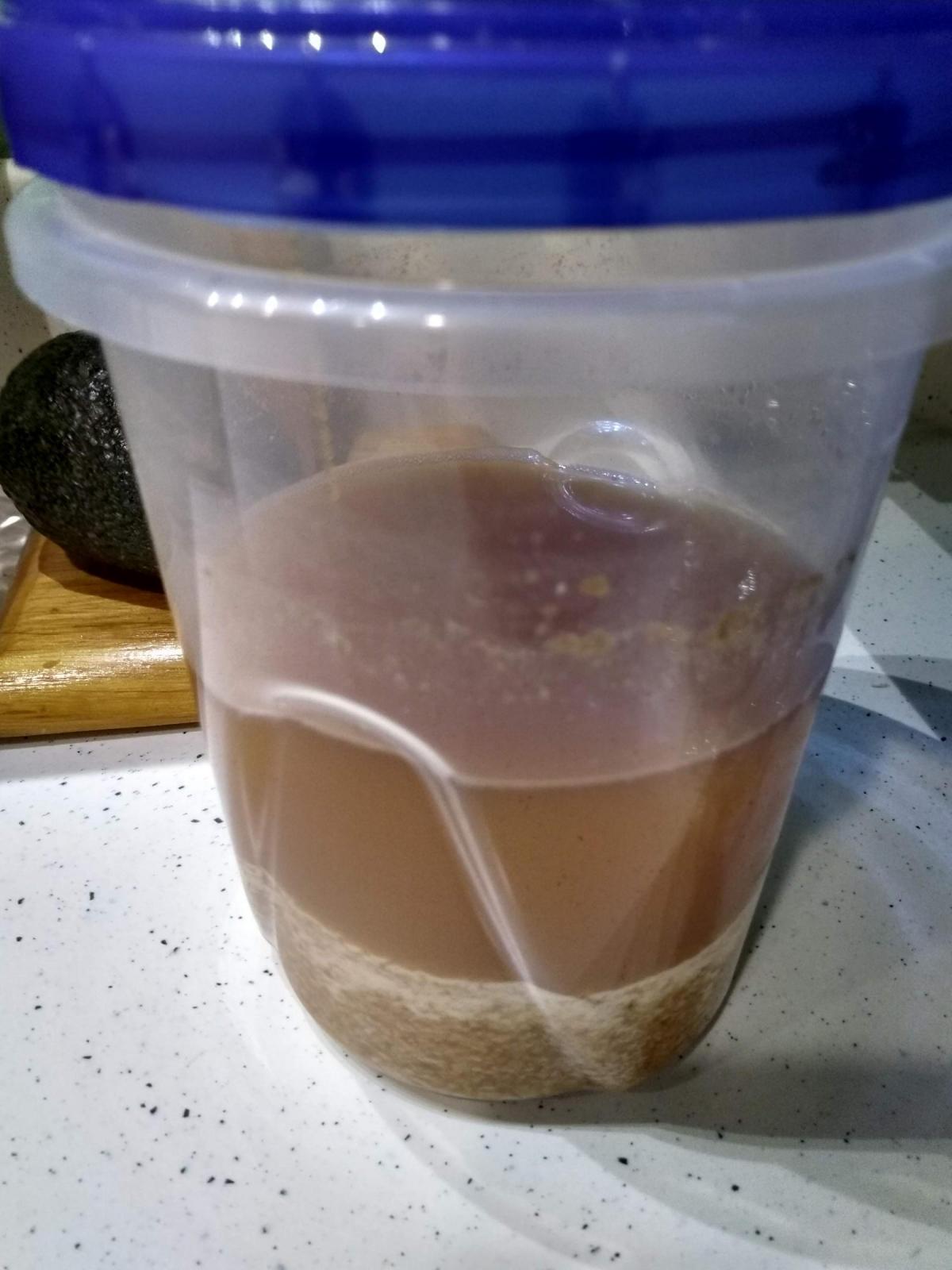
It did nothing the rest of the evening. I tossed it this morning.
Great experiment and video Danny. This has the potential to help so many people who are now wanting to get into sourdough baking, the first hurdle of building a starter is such a confusing challenge to newbies, this method should really make it easier.
Benny
I want to explore the idea of using whole grain berries instead of bran only. New bakers won’t have milling capability and the berries can often be sourced locally.
250g filtered water @ 90F
25g Rye Berries (whole)
25g Honey (tested PH @ 4.5)
Fermenting @ 84F
The last image deserves a post of its own... HERE it is.
Both of the starter above fermented and after 3 days were converted to typical flour starters. NOTE - it may best to feed the liquid starter longer, but wanted to see how fast there would convert. The bran starter fermented more than the whole berries. Given the choice bran would be best, but the whole wheat also worked. Both starter rise very fast, maybe 3 or 4 hours.
Whole Berries on left - - - Bran on Right
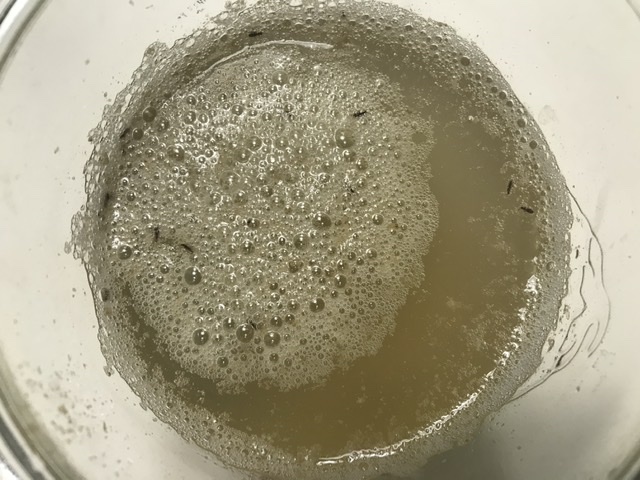
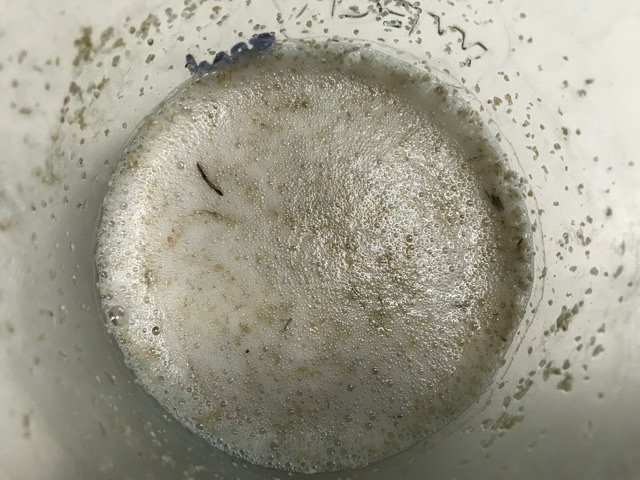
Danny
Update, I just learned from Michael that I am making Mead.
There is no end to learning...
I'm curious why you are using honey. I thought I read somewhere that it slows or otherwise interferes with fermentation? Antimicrobial properties maybe?
It occurred to me early on when I saw everyone recommending whole grain flour, and with all the people saying they could not find it because of covid (I was unable to find rye but did get WW), that a little bran added to AP flour, even bleached flour, should be useful. But I figured since I didn't see anyone recommend it, there must be a reason why it didn't work. It didn't occur to me that maybe no one had tried it.
I wonder if a bran cereal, such as raisin bran, would work? It might be too processed and have no more viable microbes on it than bleached flour does. But if it does work, lots of people have that on hand.
Glad to see I wasn't offtrack with that thought about using bran, and that someone has decided to give it a spin!
"Ready-to-eat" grain-based breakfast cereals are pre-cooked at the factory, so you can eat them out of the box. They need to be very hygeinic. And being pre-cooked, the yeast/bacteria is mostly gone.
Yes. Cooked is part of the processing I was referring to. Honestly I wasn't sure if it was cooked or chemically treated or what. So thank you for clarifying that. But it seemed likely to me it went through some sort of processing that would reduce the number of viable microbes.
I’m not aware of honey deterring fermentation. If you have some information, please send the links. I’d like to learn...
My Google search seemed to indicate that the fermentation of honey is common practice. See THIS LINK.
The reason honey was chosen for this experiment is because it is a healthy source of sugar and it is readily available to all.
Doc Dough suggested plain sugar (sucrose).
I don't really know anything. I just remembered reading that using honey in SD bread can affect the fermentation. Most likely somewhere on this forum, but not really sure where I saw it. A quick search on the forum didn't turn up anything.
So I turned to google and I didn't immediately find anything about honey affecting fermentation in a negative way. So, most likely, whatever I read was the result of someone assuming that the antimicrobial properties that honey has would be an issue, but apparently it isn't.
It is documented that honey does have antimicrobial properties, though. Here is just one link that lists it as both antibacterial and antifungal (as well as antiviral, etc), which would seem like it could have a very negative affect on a SD starter. However, it also lists honey's low pH as one of the potential factors that results in the antimicrobial action. And thanks to Debra Wink, we know that a low pH is actually a good thing for a SD starter, specifically because it does kill off a lot of microbes...just not the ones we want. They happen to like that pH so it's probably actually beneficial.
https://www.ncbi.nlm.nih.gov/pubmed/23782759
Fascinating stuff! I love finding out more about what's going on in my little zoo and the various factors that affect it.
One of the reasons (besides availability) honey was chosen was because of the low PH. Hopefully it will eliminate the Leuconostoc phase that the initial bran starter quickly went through. I say quickly (probably less than 24 hr) because the PH dropped very low, very soon in the process. That may be attributed to the buffering affects of the bran. Just a guess, though.
Danny
Don't trust anything until you have run the experiment.
Second rule:
If you run the experiment, document what you did in detail and repeat it, then post your results with the details (either confirming or refuting the original claim).
In Laurels Kitchen Bread Book it says that raw honey can interfere with long fermentation of bread because it is biologically active.
I'm going to try hard red wheat and brown sugar. Those are the most commonly available where I live.
Looking forward to reading your results.
Danny
I was corresponding with Michael, aka “mwilson” and he got me interested in using carbonated water in place of the filtered water.
Sooo,
Another liquid starter is sitting besides the other in the proofer as this is written.
150g Carbonated Water @ RT (NOTE - the carbonated water used is said to contain 2% Himalayan Salt and no other extras). I would have preferred no additives but it’s all I had available.
15g Rye Bran
15g Honey
Both are fermenting @ 82F.
That seems really strong. Not anything I would want to drink.
What is the objective of using carbonated water? Reduced pH?
You will need to keep it pressurized (typically with 20psi of CO2) to hold the pH.
The can shows 2% of the Daily Value. 2% of total would be very brine tasting. I made the correct calculation and it is 0.025% of the total weight.
Thanks for pointing that out.
Danny
Dan, was the bran you used for this store-bought or sifted out of home-milled flour?
I'm using store bought bran that has been in our pantry for a few months.
Dave, milled and sifted.
After just less than 24 hr, both liquid starters are starting to ferment.
Odly enough, the whole berries are showing slight signs of fermentation. And the sifted bran is showing minute signs of fermentation. I would have expected the sifted bran to ferment more aggressively than the whole berries.
Whole Berries (23hr) - the extra protein was gross, so it was removed after the image was taken.
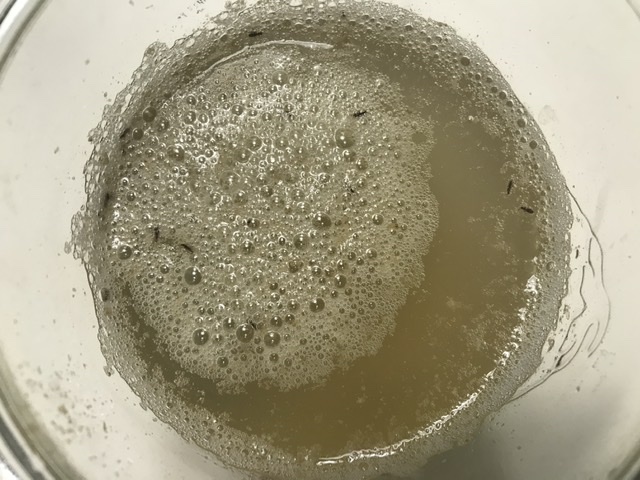
Rye Bran (20hr)
I think I know what happened with the bugs in the rye. The bucket holds ~40 pounds of berries. I am nearing the bottom and I think the bugs were dead when purchased. They probably dropped to the bottom and that may explain why I just came upon them.
In the last 8 days I have built 3 liquid starters. Each and every starter consistently benefited from additional sugar (malt syrup, honey, etc) when the fermentation slowed down. Once the original starter starters to bubble watch it. When the bubbling slows down it is time to give it more sugar. Unless I’m mis-interpreting something, these starters are voracious! Below is one example.
At 9AM the starter was barely fermenting. There very few bubbles on the surface and the audible fizzing was almost nil. So I gave it 10g of honey. 4 hours later it was fermenting at an above moderate pace. These starter are hunger when kept in a warm environment.
The starter imaged above is 24 hr old. There is no indication of Leuconostoc bacteria. The starter smells and taste good. Although this starter would best be served by waiting a few days to mature, I am reasonably sure that a standard levain could be made right now, and a dough mixed in 8hr that would make an acceptable loaf.
The combination of the microfilm on the outer coating of the berries , coupled with the sugar (the steriods) are raising viable starter in short time. I am not advocating using these starters so quickly, but it is possible to do so.
I look forward to the results of others that are running similar trials.
The latest 2 liquid starters are producing alcohol. Have posted guards to watch for winos. <LOL>
Decided it is time to wean these babies off sugar. I fed the 1 tablespoon of flour last night.
Image below after fed a couple of hours prior.
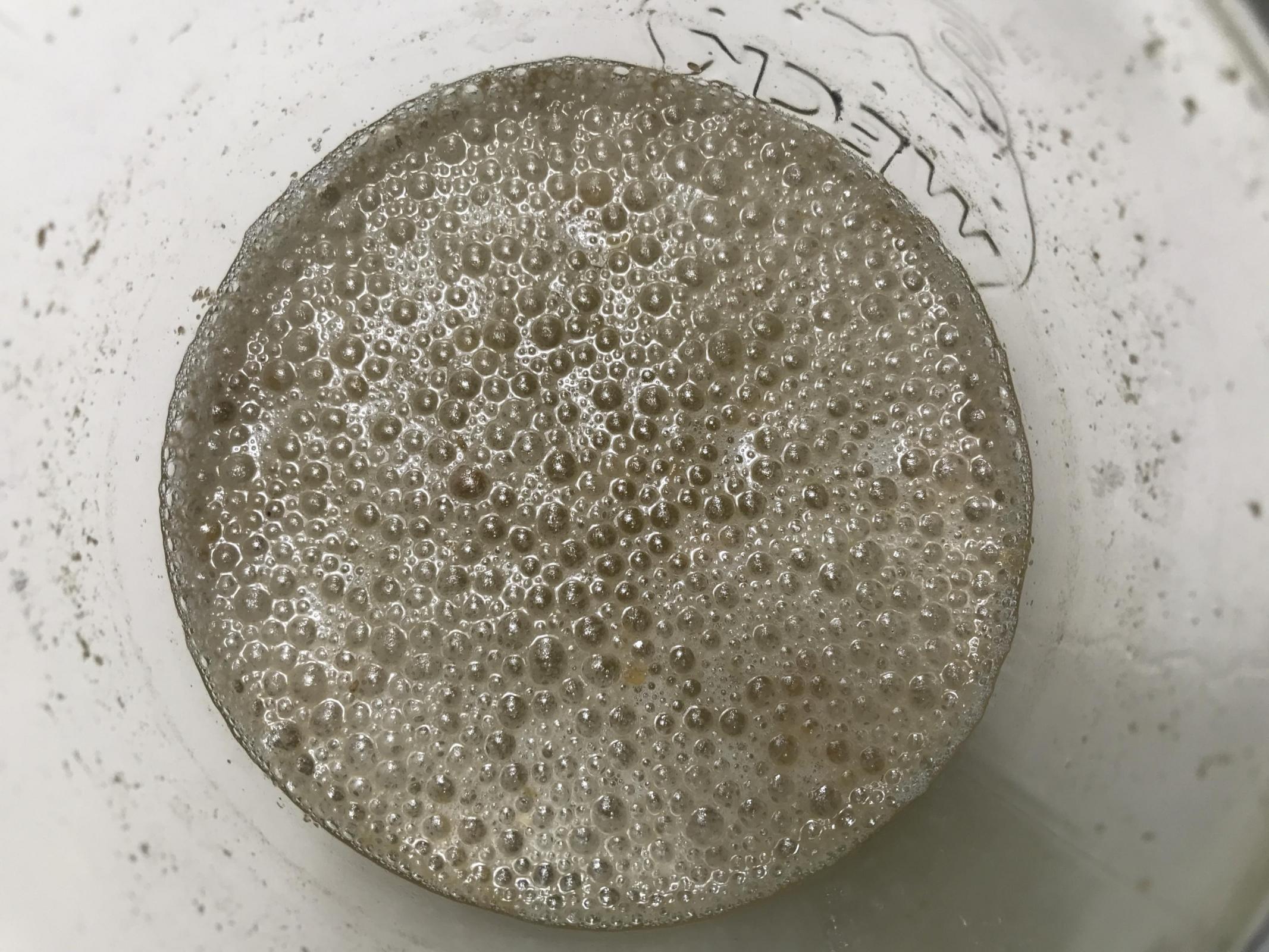
12 hours later.
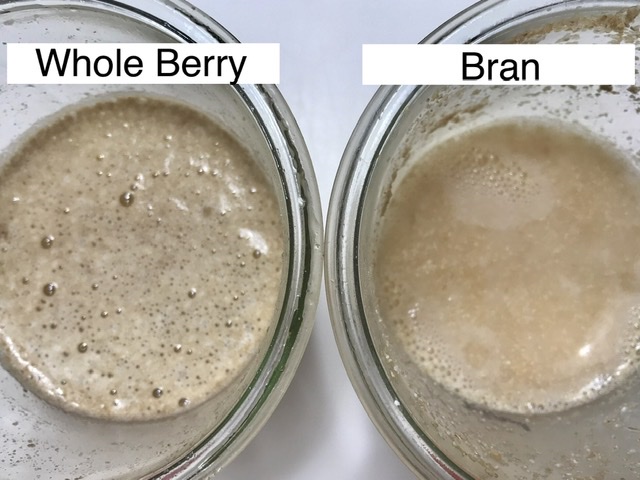
According to smell and taste these liquid starters get very acidic, very quickly.
May 22 - Time to convert to a typical floured starter.
These things are fermenting alcohol...
Is there a leuconostoc or other "bad bacteria" phase we have to get past in this method?
I probably won't be using honey, but one of: dried malt extract, or dextrose, or table sugar.
I will be interested in your experience if you choose to use straight table sugar. I presume that it will need an enzyme to cleave off the glucose (which may be in the grain, or produced by the yeast), and some yeasts and LAB use maltose preferentially when they can get it.
Thanks. Now I'm going to have to make some "invert syrup" and try that too.
--
For those who don't know, "invert syrup" is made by disolving table sugar in water, and heating it up, and maybe using a little Vitamin C citric acid, to separate the sucrose into fructose + glucose. See: https://en.wikipedia.org/wiki/Inverted_sugar_syrup
It's a safe bet that wherever there is plant matter or a significant presence of yeasts then there is invertase. Still I agree a trial with sucrose would interesting...
AFAIK, as a default characterization, yeast will always preferentially uptake glucose even those that are maltose positive.
Sucrose is the sugar that is transported through the veins (phloem) of plants.
Good reference paper here characterizing a bunch of different yeasts from brewing, baking, wine making, alcohol production, and 2 laboratory yeast strains.
And I didn't know that sucrose was the form of sugar transport in plants. Thanks for that!
Apparently (according to the Encyclopedia of Food Microbiology) l. sanfrancisencis (and some other LAB) prefer maltose to glucose
Doc (and anyone else that might know), all of these types of sugar are unknown to me. What would you suggest as the perfect sugar (excellent for all types of yeast and LAB)?
Since you don't know what the yeast or the LAB are, you don't know what they prefer, but what you feed will to some extent determine what you encourage. After you transition them to flour, the dominant sugar by availability is maltose. So malt syrup might be a logical choice.
250 grams filtered tap water
25 grams organic hard red winter wheat berries
25 grams organic brown cane sugar
Warmed the water slightly, stirred in sugar until dissolved, added wheat berries. It will live in the Wedgewood prooving shelf (the former home of the previous apple-water yeast and raisin-water yeast builds.)
Day 3: the wheat berries are tipped with bubbles, and there's a bit of foam on the water surface. Very slight, barely detectable gas release from the not-completely-tightened jar lid. The smell is of brown sugar and grain, with a hint of beer. If it was a fruit yeast water it would be fizzy, ready to bake with, and starting to smell of alcohol by now. I'm not comfortable tasting it yet (who knows what's going on in there) so I'm just going to keep an eye on it for a few more days and see if it turns into anything.
Day 4 and the small amount of bubbling pretty much stopped. I added a teaspoon of honey, because it seemed like the brown sugar just wasn't that great. We'll see if the honey inspires more activity.
This ferment clearly prefers honey to brown sugar. One day after giving it a teaspoon of honey it is full of bubbles and is building pressure. The taste is quite sweet and fizzy, like warm honey soda. The smell is of honey with a faint undertone of yeast. I think it would probably raise bread, although it's certainly not a sourdough: it's a classic yeast water.
Is the goal to transition these to sourdoughs? Do we know if that is likely to occur at some point? Right now there doesn't seem to be any Lactobacillus activity in this ferment.
Jess, I have every reason to believe these liquid starters are fermenting yeast and LAB. The sugars may be throwing you off.
At this time I have a whole berry and also a bran liquid starter on the counter. They are producing alcohol. Also of interest these starters have low PH of ~3.5 .
Just today and for the first time I fed both a tablespoon of flour. Wanted to see what would happen. Sugar and honey doesn’t appear to last very long.
Danny
After adding honey on day 4, this ferment is now very lively and fizzy and has developed a cap of stable foam. Flavor is developing a bit of tartness and a bit of yeastiness. Flavor profile honey>cider>beer. Here is a picture of it alongside the apple/raisin yeast water. I'm going to make two small levain builds with these waters and some fresh-milled hard red wheat, each at 100% hydration, and see what they do.
After 4 hours, sourdough looks good, wheat berry
Danny, I'm calling this experiment a success.
It looks like the wheat berry/honey ferment will raise dough. The levain is close to double at hour 5. What would be helpful at this point? Would you like me to let it peak and then feed it again as if it were a regular sourdough? With a 2:1:1 or a 1:1:1?
going back to using my rye starter. I'll take the one on the left, please. I tend to use the yeast water to soften doughs as an additive although they can raise dough too. If there is no available yeast or sourdough starter, making a yeast water starter is easier. Then in a few days the rye starter is up and running.
Did you put up a few "controls" like honey and water? I want to put a stick blender into the apple water and give it a whirl. Wait for the action and then inoculate flour with no added water.
Just the apple water build and the rye starter build for comparison. I guess I could split the wheat berry yeast water levain and feed half of it with wheat flour and half with ryeflour to see which turns into sourdough starter first, if either. I'm thinking a 2:1:1 for this first refresh feed.
you used to wet the flour as i see almost no difference the the second picture as to their amounts. Did you add water to the flour? Or the yeast waters? That might explain the low rises.
Both of those builds were 1:1 yeast water to flour. Clearly my apple yeast water has gone amiss somewhere but after 5 hours the wheat berry YW levain has doubled in volume.
After creating a mother from flour mixed with the wheatberry-and-honey yeast water I refreshed it (switching to rye and plain filtered water for refreshes) a few times and then I baked a little test loaf. It rose and baked fine.
Unfortunately I underproofed the final rise because I was paying more attention to my other full-sized bake using my conventional sourdough, which proofed a little faster. I also may have made an error when calculating the salt, because although the flavor is decent, very faintly tangy, it's kind of salty tasting. In short, I have no future as a lab technician.
However, I have continued to refresh the mother morning and evening using 1:2:2 rye flour and plain water, and it is vigorous and is developing more of a tart scent. I think we do have a viable method of easily creating a sourdough starter. I will bake another test loaf today.
I refreshed the starter again this morning and tasted the bread I made from it yesterday. The bread is ok although a bit salty, but the starter really doesn't smell that great to me. The funk is off-putting. I don't want to make bread with it. It just doesn't have the pleasing, fresh, sour-apple smell of my traditional rye starter. I don't even want to add it to my discard bucket.
So I decided to make a new mother with what's left of the yeast water, which now smells quite sharp. Maybe I will get a more pleasing result from a later-stage water ferment.
I did the build as before, 1:1.
Half wheatberry-and-honey yeast water, half fresh-milled rye flour.
I like the smell of the build from the 10-day-old yeast water better than the mother made from the 8-day-old water. It is fresher and tangier smelling. It needed a stir and a sit to rise before it was ready to be refreshed. I think this method could be recommended to a beginner wanting to more easily start a sourdough mother. However, it isn't necessarily faster than the procedure recommended by Debra in the Pineapple Juice Solution. She says yeast will start to grow between day 3 and day 5, depending on the weather. Her method does require some kind of whole grain flour though. And a bit more fussing. Though feeding a few teaspoons of flour and juice once a day isn't much trouble.
Jess, I appreciate the time you took to report your findings.
Thanks,
Danny
Dave, the first starter passed through the “bad bacteria” stage in about 24 hr. The other 2 are only a little over a day old but show no indications of it. Maybe the acid in the honey helped, maybe not. But in any case it wasn’t a big problem.
Continuing Data
Refrigerated the liquid starter on May 7.
Removed from refrigerator May 18.
It was fizzing exactly like you would expect a Yeast Water thta was refrigerated to act.
I wanted to see if my natural real honey would ferment and give me a powerful yeast water. After a few days added a little table sugar. Well. Still testing to see if it will raise wheat dough. I kept it at 22°C for two weeks shaking everyday and keeping a loose cap on it. It burped every time after shaking. It now sits in the fridge with a small sediment. Not pasturized. So far not impressed. wine yeast? High elevation 600m flower honey. Ive been told I'm making an "Essigmutter."
Mini, are you working with an actual YW or a bran or whole berry liquid starter?
I have a question for anyone that can answer.
Why doesn’t YW have LAB? It seems to me the microflora on fruit, flowers, etc. would be very similar or identical to the microbes that settle on wheat grain.
LAB fermentation of fruits and vegetables is called making pickles. Or kimchi, or sauerkraut.
I learned to make fermented pickles last year, and it was always, always done with the addition of salt to suppress other microbial activity. Perhaps the answer is that fruits and vegetables do have LAB but the yeast is so much faster and more aggressive the LAB can't get started unless you help it by using salt to suppress the yeast.
I think the answer has something to do with maltose. Or at least that's my first guess. I don't remember the details, but one of either the yeasts or the LAB can't metabolize maltose and the other can. This is part of why they can live in balance with each other so happily. I'd have to do some digging to try to figure out why this works with flour & water to make sourdough, but not with raisins & water to make YW. But I bet someone else around here already knows the pieces.
I'm still confused about the distinction you are making between a yeast water and a whole berry or bran liquid starter (with sugar of some kind added.) Is the idea that adding grain removes it from the yeast water category?
These liquid ferments with sugar/honey/molasses/etc added seem like yeast water to me....
LAB fermentation has been utilised for centuries as a way to make foods stable, less susceptible to spoilage and suitable for long term storage.
Many mistakenly think that LAB favour an acidic environment. In actual case LAB are responsible for making the environment acidic. Unlike yeasts their growth is very pH dependent.
SD starters often range between pH 3.7-6 and many SD specific LAB stop growing below pH 4. LAB prefer only mildly acidic environments. E.g. vegetables, grains, meats which are around pH 5-7.5.
Yeast waters will often stabilise at around pH 3.5 since many fruits are somewhere close to this pH. At this low pH, growth of LAB is not favourable.
Other factors relate to nutrition including, available protein sources of which LAB and yeasts generally have a different preference of type.
LAB thrive in SD starters because we bakers refresh them, which brings the pH back up to around pH 6 (the pH of flour). As the dough or batter ferments and become more acidic their growth continues to slow and eventually stops.
Thanks for such a clear and concise explanation. Since it is off topic and a subject of high potential interest, a separate topic on this was posted HERE.
It deserves to stand alone.
of lactobacteria? Environment plays a big role where they grow.
https://en.m.wikipedia.org/wiki/Lactobacillus